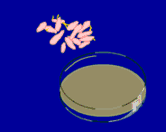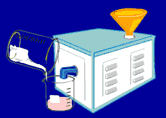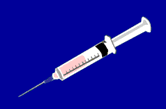
Step 1
Use the growth medium to grow new copies of the
Clostridium tetani bacteria.
|
|
With a toxoid vaccine, the goal is to condition the immune
system to combat not an invading virus or bacteria but rather
a toxin produced by that invading virus or bacteria. The
tetanus shot is such a vaccine. Tetanus is a disease caused by
toxins created by the bacteria Clostridium tetani. The
vaccine conditions the body's immune system to eliminate these
toxins.
To produce the vaccine, you first need to grow many copies of
the
Clostridium tetani bacteria.
|

Step 2
Isolate the toxins with the purifier.
|
|
While in the growth medium, the bacterial cells produce the
toxin, which are toxic molecules that are often released by
the cells.
To produce the vaccine, you'll need to separate these
molecules from the bacteria and the growth medium.
|

Step 3
Add aluminum salts to the purified toxins.
|
|
In this state, the toxin would be harmful to the human body.
To make the vaccine, it needs to be neutralized.
Sometimes formaldehyde is used to neutralize toxins. For your
vaccine, you'll use aluminum salts to decrease its harmful
effects.
|

Step 4
Fill the syringe with the treated toxins.
|
|
The toxin would work as a vaccine now, but it wouldn't
stimulate a strong immune response. To increase the response,
an "adjuvant" is added to the vaccine.
For the tetanus vaccine, another vaccine acts as the adjuvant.
This other vaccine inoculates against pertussis. The vaccine
for diphtheria -- also a toxoid vaccine -- is also often added
to the tetanus/pertussis combo, making for the DPT vaccine.
|

Done
The tetanus vaccine is complete.
Select another pathogen.
|
|
Congratulations. You have produced a toxoid vaccine for
tetanus.
As with other inactivated vaccines, there are disadvantages
with toxoid vaccines. Even with the adjuvant, these vaccines
do not produce a full immune response. Booster shots are
needed to maintain the immunity.
|
